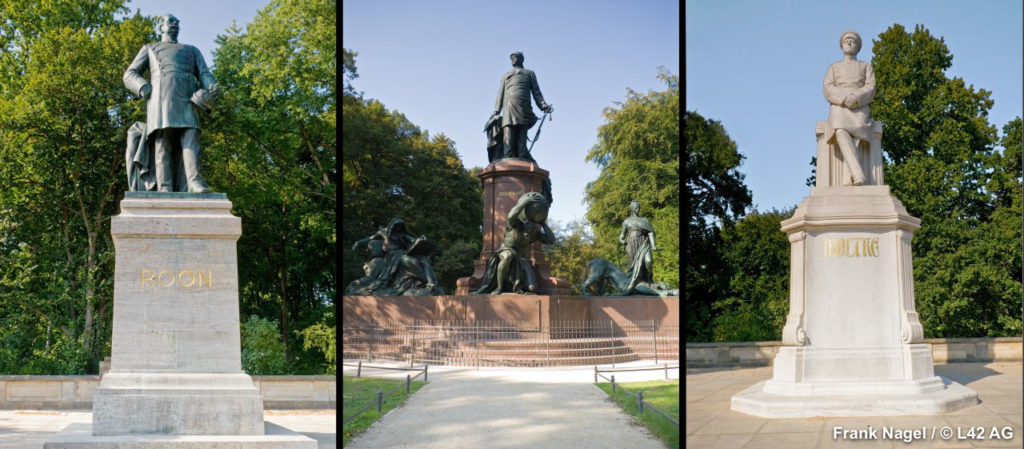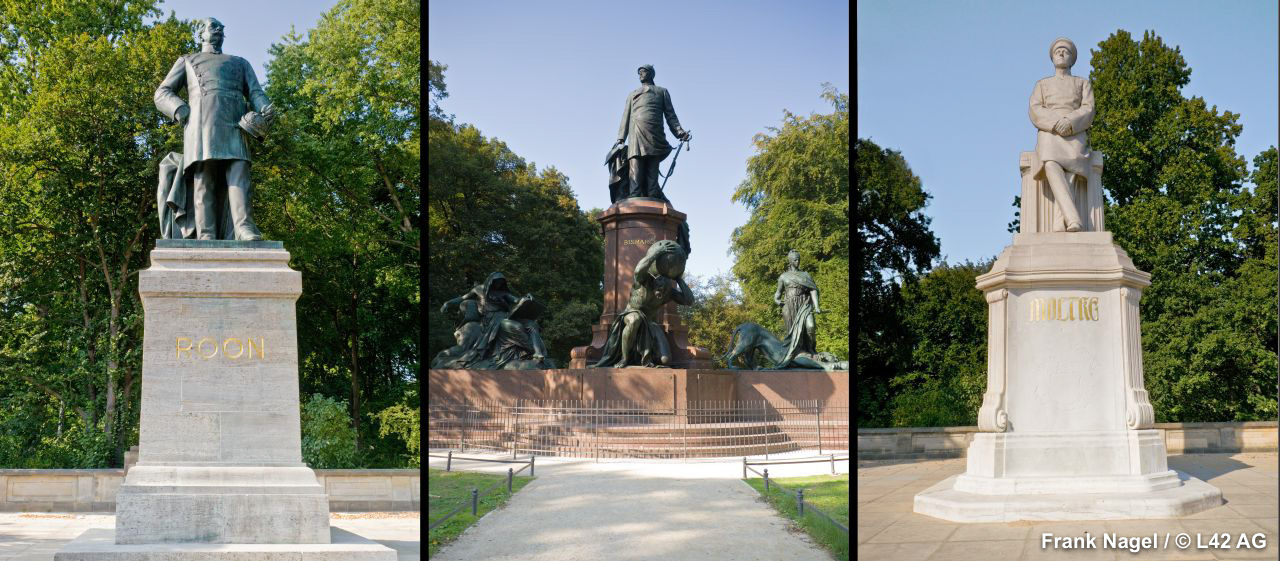
Große Stern or Big Star is quite an important name and the poet enjoys visiting this huge square at the center of the former imperial hunting grounds known as the Tiergarten. As it happens to be at the crossroads of various attractions – the large park of the Tiergarten itself with its little lakes, statues, sweet smelling rose gardens, the President of the Republic’s residence of Bellevue, the not-too-distant Brandenburg Gate, the Spree mirroring back the latest avant-garde facades of the buildings along its banks –, the square is always full of tourists.
The poet, of course, is usually attracted to more intimate, hidden, and unknown spaces. Visitors, however, are irresistibly drawn to the Big Star with its central Victory Column topped by a golden statue who holds a crown of laurels in her right hand and a scepter in her left and looks out over the Straße des 17. Juni while the wind lightly ruffles her clothes and her wings. So what exactly is the poet doing here at the Big Star, then, perennially full as it is of city buses, tourist buses, taxis, bicycles, rickshaws, and Segways and where there is always the danger of some skater running over your toes? He has come to find the saintly trinity in which the whole of Germany is incarnated: the “Iron Chancellor” Bismarck, General Roon, and General Moltke.
Whenever the poet is confronted with questions of a political-metaphysical nature – for example, where do we come from, where are we going, etc. – he comes here to talk with them and he believes they answer. That they were important in their time you can see by the size of their statues. And yet, hidden away as they are at the northern end of the square where the sun never shines, it’s easy to get the impression that their time is undeniably over. They keep Victoria company, of course, but not a single tourist ever notices them and so, despite their size, for all intents and purposes they remain invisible.
Bismarck wears a pointed Pickelhaube and with his left hand is pointing a sword at the ground while with his right he lightly fingers the drapery, as was customary at the time when posing. His bust is erect and his legs are perfectly in line with both his feet (poised perfectly at 10 o’clock and 10 o’clock) so that it almost seems like he’s in the first position of classical dance. He is wearing a Prussian uniform (which looks a lot like a peacoat), which too is rippling lightly in the wind, though it isn’t the same wind that’s bringing life to Victoria. In fact, every statue here seems to have its very own. The Iron Chancellor is looking at the ground, but as he is standing behind General Roon, the poet is convinced that the former is controlling the latter. Bismarck is standing upon a base where his virtues have been allegorically represented. Indeed, for a statue, it is not enough to represent the idea of one’s great personality. More than simply a statesman, here Bismarck is represented as a superhero. The woman crushing the leopard – a symbol of power – is Germany; Atlantis – who is carrying the world on his shoulders – represents the chancellor’s titanic majesty; the Sibyl alludes to his political wisdom; and the Sphinx symbolizes the great Otto’s spiritual gifts. “Super Otto,” the poet points out. The memorial statue of Bismarck was originally made by the famous sculptor Reinhold Begas to stand in the garden square in front of the Reichstag. Just a little before the Second World War began, the architect Albert Speer had it transferred here as it interfered with his plans for the square, which, in the end, wasn’t really a bad thing as it likely would have suffered greater damage seeing that the square was largely destroyed.
General Roon, the Minister of War at the time of Bismarck, is scowling and looking towards Potsdamer Platz. He has taken off his helmet. And though he is standing in front of Bismarck, not a breath of wind moves about him and his jacket is hanging straight down. He has one hand poised on his hip, the veins are standing out in his face, he has a pointed moustache, and he is wearing the Iron Cross.
General Moltke is a dazzling white and his rugged gaze and the wrinkles about his mouth suggest he has seen quite a lot indeed. Leaning back against a base, his right leg is crossed over his left and his left hand crossed over his right. Interestingly, you can see the veins on him, too. He looks like he’s simply waiting for the bus, or like a sailor on shore leave waiting for his girl down on the docks. But, being where he is, he too is having a look up at Victoria. These observations naturally come from the poet, a liberty he allows himself to take for General Moltke, he tells us, is his best friend.
All three generals lived during the 19th century and were among the major contributors to the birth of the German empire and Germany as a European power to be reckoned with. At the end of their glorious careers all three were awarded noble titles and thus, in reality, should be referred to as Graf (count) von Bismark, Graf von Roon, and Graf von Moltke.
The conservative monarchist Graf von Roon is responsible for being among the principal modernizers of the Prussian military. Having observed their inefficiency, at not even thirty years of age in 1832 he wrote Grundzüge der Erd-, Völker-und Staatenkunde, in English Principles of Physical, National and Political Geography. His theories enjoyed a discrete amount of success, and he thus became tutor to Prince Friedrich Karl of Prussia. Von Roon made the Landwehr a permanent reserve regiment to act when the rest of the army was otherwise actively engaged, a move which was, to say the least, rather unpopular seeing as it required the engagement of practically the entire male population of Germany. Be that as it may, the Austro-Prussian War in 1866 and the Franco-Prussian War between 1870 and 1871 ended up proving him correct.
As far as Bismarck is concerned, however, we know almost everything there is to know. He was the first minister of Prussia before the unification of Germany in 1871 and he continued in his role as Chancellor of the German nation up until 1890. Now, you have to admit, thirty years at the head of the government isn’t too shabby. In any event, he is always represented as a rather robust and certainly severe man of state.
In a whisper the poet tells us that the young Bismarck was slim, didn’t study much as he was busy carousing with other students, and, above all, enjoyed organizing duels, the national sport of the time. He fell in love with two English girls, but then decided to become chaste and clean. He married, had three children, and channeled his energy into debate and political commitments. That is, until Wilhelm I – tired of having him hanging around all the time – sent him off first to Saint Petersburg as ambassador, then to Paris, and finally back to Berlin when his indestructible hardness was once again required. And it was in Berlin that Bismarck was to remain until the end of his days, of great importance, if barely tolerated, to both Wilhelm I and his successor Wilhelm II. Ironically, it was precisely Bismarck’s iron-like personality that made him ever more popular among the population. Who, on the contrary was always loved by all is General Moltke, and he is also the poet’s best friend.
General Moltke was born in 1800 into an aristocratic family which had suddenly fallen upon hard times thanks to a reverse in fortune in the dukedom of Mecklenburg-Schwerin up at the border with Denmark. His father was a Danish citizen and so the young boy became one too. He was sent to cadet school and then entered the Danish army. Gifted with great intelligence, he soon stood out and became a second lieutenant and page to the king. At 21 he decided to leave the Danish military and, though it meant losing seniority, start over from scratch in the Prussian army. There he was also immediately appreciated for his level of culture and dedication. In 1827 he published a novel entitled Zwei Freunde (Two Friends). After that he wrote political works on Holland, Belgium, and Poland. Needing money to purchase a horse, in 1832 he accepted the job of translating Edward Gibbon’s twelve-volume history The Decline and Fall of the Roman Empire into German for a total of 75 marks. In only eighteen months he managed to finish nine of the twelve. The publisher, however, never managed to publish the book and Moltke never received more than 25 marks. In 1835 he was promoted to captain and awarded leave. He decided to spend six months in southeastern Europe. In Constantinople he was asked by Sultan Mahmud II to modernize the Ottoman military. He asked Berlin for permission to stay two years; he ended up staying four, working in other countries as well.
When he returned to Berlin he married an English woman, Mary Burt, drew a map of Asia Minor, and began to become interested in the railroad. In 1857 he was promoted Chief of the Prussian General Staff, a position he was to hold for thirty years.
This should be enough for him to be remembered, but he is remembered, above all, for other things.
Moltke turned the military into what it is today, that is, a flexible force which knows the strategy of its enemy and is able to overcome unexpected situations. He enjoyed great success in the war against Denmark in 1865, and again in 1866 against Austria, as well as against France in 1870 and 1871, a war which concluded with German victory in Sedan and the country’s very unification. The reasons for these victories are also attributed to the synergy of forces between great strategy and Minister of War Roon who provided him with an ever more professional and efficient army.
The poet takes picks up a branch and begins to illustrate his friend’s thoughts by scratching into the dirt. “‘Strategy is a system of expedients.’ First point: ‘No battle plan ever survives contact with the enemy.’ In other words, you can only ever plan the beginning of operations, after that, military strategy consists in trying to understand all the possible number of outcomes. This concept was extremely modern at the time and has remained the cornerstone of modern military strategy up until today. Second point: ‘March separately, attack together!’ Groups have to move separately in order not to become an obstacle to reinforcements and not to waste logistical energy.”
He pauses a moment and raises his eyes. An immense squad of tourists is marching toward the Siegessäule. He lowers his head and begins again.
“Third point: A flank attack is more effective than a frontal attack.”
No doubt.
We timidly allow ourselves to ask our friend what it is that could so firmly bond a military strategist to a poet. He responds that General Moltke was a polyglot who enjoyed the ability to remain quiet in seven languages. He tells us that Moltke’s difficult childhood had given him the capacity for self-control and the ability to never make a false step. That he was loved and admired, above all, for being successful and for becoming famous. “‘Freundlichkeit gegen jedermann’ – Moltke used to say – ‘ist die erste Lebensregel, die uns manchen Kummer ersparen kann’” – “Kindness towards everyone is the first rule of life that can save us a lot of trouble.”
He was noble indeed.
Translated by Alexander Booth

